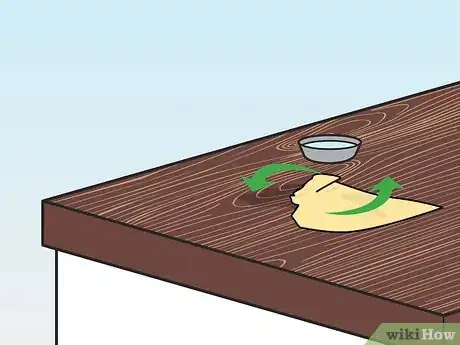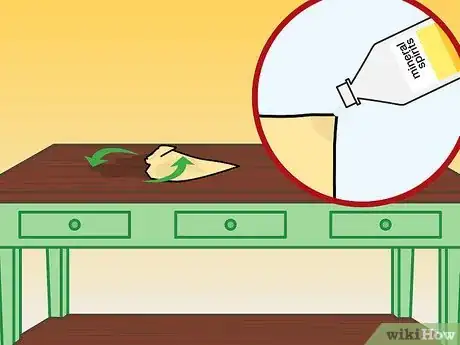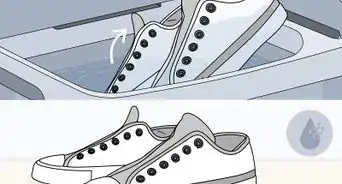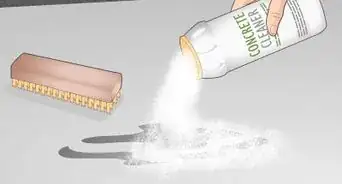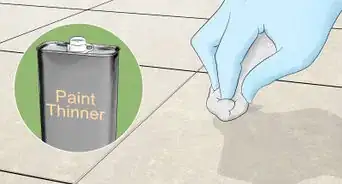This article was co-authored by Guy Peters. Guy Peters is the Owner of MOP STARS Cleaning Service, a complete house cleaning service for residential and commercial clients, based in Denver, Colorado. Founded in 2014, MOP STARS provides regular, move in/out, deep, and commercial cleaning services. Guy has a BA in Finance from the California State University - Sacramento and an MBA from Cornell University.
This article has been viewed 221,175 times.
Because wood is porous, it absorbs oil very quickly, often leaving a nasty stain. Whether you’re dealing with cooking oil spills on floors and benches, or hand oil from repeated use of furniture and doors, removing oil from wood presents a challenge. However, with a bit of elbow grease, and a few simple home remedies and techniques, it’s relatively easy to remove oil from wooden surfaces and furniture.
Steps
Removing Oil from Recent Spills
-
1Soak up the oil with a paper towel. Treat oil stains on wood as soon as they occur to prevent the oil from sinking deep into the wood and causing stains. Blot the stain with paper towels, newspaper or blotting paper, pressing the paper firmly until you’re sure you have soaked up the oil.[1]
- Wear rubber gloves throughout this technique to avoid any skin irritation, especially if you have sensitive skin.
-
2Mix up a mild detergent solution in a bowl. Place some warm water in a bowl and add some mild detergent. Use your hands to mix the solution and create soapsuds.Advertisement
-
3Clean the oily area with your solution. Place some of the soapsuds onto the stained area with a clean cloth and rub onto the affected area. Be gentle enough to avoid scratching the wood, but firm enough to work the suds into the wood grain.
- For more stubborn or deeper stains, scrub the soapsuds in with a soft brush.
- Always use a cotton ball or soft rag to clean your wood surface. Avoid harsher abrasives like steel brushes, as they may scratch your wooden surface.
-
4Rinse the wood with clean water. Once you have finished cleaning, rinse the area with clean water, or wipe it down with a clean damp cloth. This will remove any remaining oily residue or soapsuds.
-
5Pat dry the wood with a clean cloth or towel. Drying the wood removes moisture so you are better able to determine if the stain has been removed.
- Allow the wood to air dry if it is still not completely dry.
- Once the wood is completely dry, check to see if the stain is still there. If still evident, you’ll need to apply further treatment.
Using Mineral Spirits for Stubborn Oil Stains
-
1Apply mineral spirits to the stain. Dampen one corner of a clean cloth or cotton ball with some mineral spirits. Rub firmly in a circular motion over the stained area in small sections at a time, being careful not to saturate the wood. If the stain is light, the mineral spirits should clear the stain away.
- Mineral spirits is a solvent commonly used for paint thinning. It is readily available at hardware stores.
- Mineral spirits is very strong and can cause skin irritation, so be sure to work in a well-ventilated area. Also, slip on a pair of rubber gloves.[2]
- If the stain is particularly stubborn, you may need to repeat this step a few times.[3]
-
2Wash off the mineral spirits with detergent, and pat dry. Using a clean cloth, wipe off the mineral spirits with a solution of detergent and warm water, rinse with clean water, and then dry with a cloth or towel.
-
3Allow the wood to dry completely. When the wood is dry you will be able to tell if you have removed the stain. If the mineral spirits have not done the job, you may need to repeat these steps.
-
4Polish the wood with a soft cloth. Once the surface is dry and the stain has been removed, it’s a good idea to polish the wood to restore its luster.[4] Apply wood polish sparingly with a soft cloth. Rub in a circular motion until all the polish is absorbed by the wood.
Removing Hand Oil from Wooden Furniture
-
1Apply a small amount of turpentine to the corner of a white cloth. Turpentine is a common solvent that can be useful for cleaning oily build up on surfaces.[5]
-
2Rub the furniture gently with the turpentine in a circular motion. Rub for a few moments until the built up oil and dirt is removed from the wood. You should see the cloth begin to discolour as it picks up oil and grime.[8]
-
3Clean the area with a damp cloth. Giving the furniture a final wipe with a clean, damp cloth will remove any remaining turpentine or oily residue from your wooden furniture.
References
- ↑ https://www.property24.com/articles/how-to-remove-oil-stains-from-wood/22744
- ↑ https://www.property24.com/articles/how-to-remove-oil-stains-from-wood/22744
- ↑ https://www.property24.com/articles/how-to-remove-oil-stains-from-wood/22744
- ↑ https://www.youtube.com/watch?v=wOK64DynbMQ
- ↑ https://digitalcommons.usu.edu/cgi/viewcontent.cgi?article=1505&context=extension_histall
- ↑ https://www.youtube.com/watch?v=B0iXS3AkYgE
- ↑ https://www.youtube.com/watch?v=B0iXS3AkYgE
- ↑ https://www.youtube.com/watch?v=B0iXS3AkYgE
About This Article
While removing oil from wood can be challenging, a few simple home remedies and techniques can make the process relatively easy. If you’ve had a recent oil spill, blot the stain with paper towels, newspaper, or blotting paper. Press the paper firmly until you’ve soaked up all of the oil. Next, mix some warm water and mild detergent to clean the affected area. When you finish cleaning, rinse the wood with clean water and pat it dry with a clean cloth. For more stubborn oil stains, dampen a clean cloth with mineral spirits and rub it firmly in a circular motion over the stained area. When the stain lifts, wash the mineral spirits off with a solution of detergent and warm water, then rinse it clean and pat it dry. Once the surface is dry and the stain has been removed, polish the wood to restore its luster. To learn how to remove hand oil from wooden furniture, keep reading!


